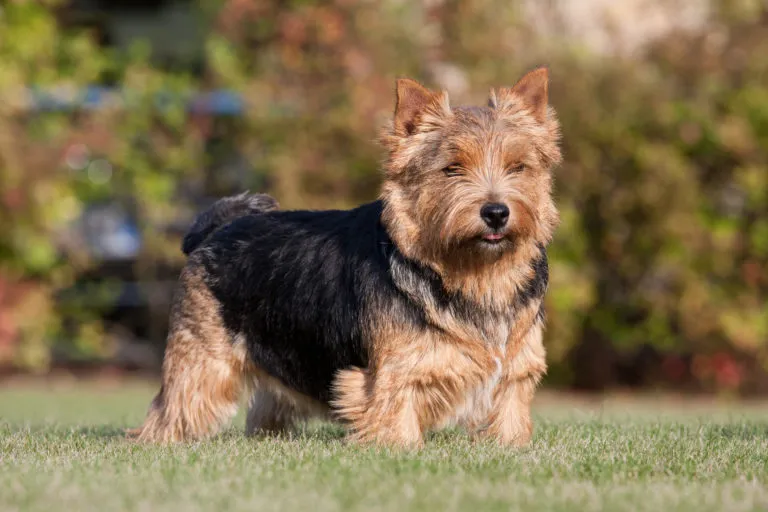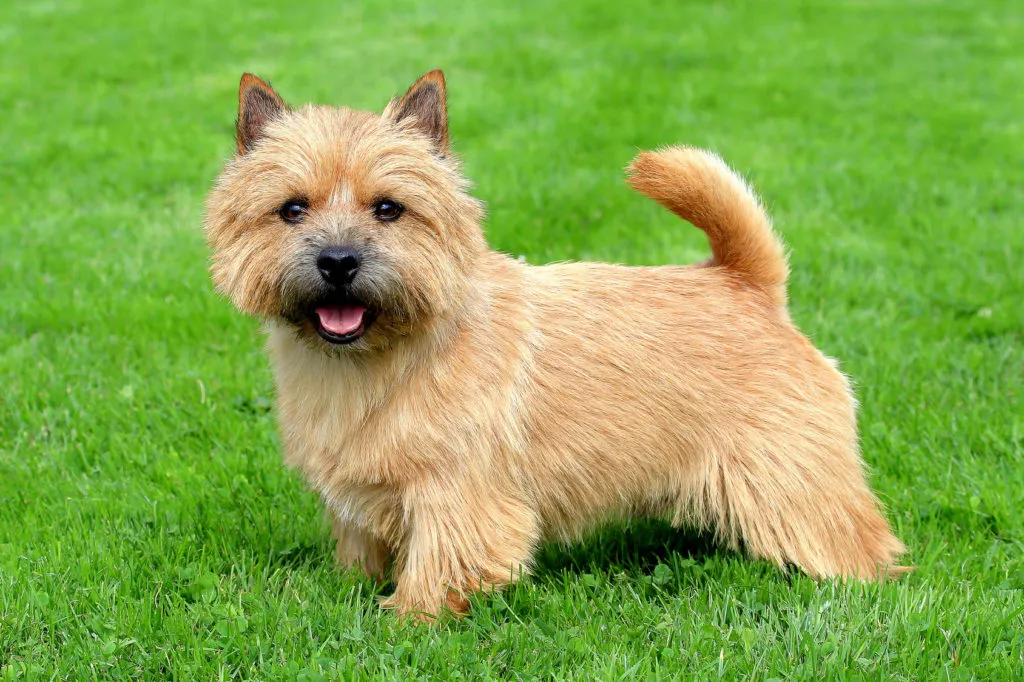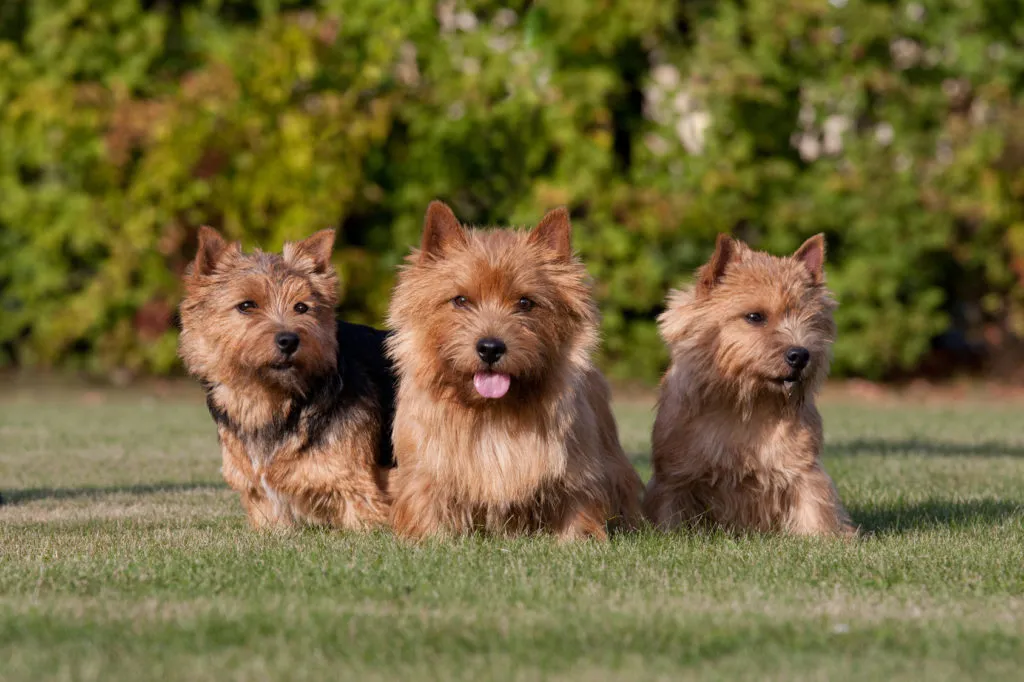Medium Size Poodle
Are you looking for a clever companion with a gentle terrier heart? The Norwich Terrier might be your ideal match!

© lenkadan / stock.adobe.com
Bright, cheerful, and people-loving: the Norwich Terrier makes a delightful family companion
The Norwich Terrier is among the smallest terriers around: Standing up to 26cm at the shoulder and weighing no more than 7kg, it is a compact, muscular, and relatively stout dog with a short back and short legs.
What sets this breed apart are its erect, pointy ears that sit wide apart on its head, distinguishing it from the closely related Norfolk Terrier. The fur is wiry and straight with a dense undercoat, and the colour can range from red, wheaten to black and tan.
 © Vincent / stock.adobe.com
© Vincent / stock.adobe.com
People-oriented, alert, and cheerful: a Norwich Terrier makes a wonderful family dog. These happy dogs are affectionate and form a close bond with their person – naturally, such a cuddly dog shouldn’t be left alone for long.
These charming Brits are lively, enjoy playing, and get along well with children. They’re also attentive watchdogs, alerting to any suspicious noise without being excessively barky. Generally, they are sociable with other dogs and open to new people. Despite their rat-hunting origins, they still enjoy going on the occasional hunt – and might not stop at the neighbour’s cat. If you have a cat, it’s best to choose a Norwich Terrier already experienced with cats, perhaps one raised with them by a breeder.
Norwich Terriers are not typically prone to constantly challenging hierarchy, making them very pleasant dogs for first-time owners. Consistency is key, nonetheless, to transform a boisterous teenager into a well-behaved adult Norwich Terrier.
Puppy play sessions are a great support in this, allowing the young dog to meet many breeds, positively influencing their social compatibility. After initial play sessions, attending dog school to learn basic obedience is beneficial – focus primarily on the recall command, given their rat-hunting background. Dog schools with terrier experience can be advantageous.
Although generally robust, some lines of Norwich Terriers can have a tendency towards epileptic seizures. Thankfully, consistent breeding efforts have reduced the incidence rate in recent years. Discuss this health concern with your breeder: A serious, health-conscious breeder will gladly explain how they minimise the risk through selective breeding.
Norwich Terriers can also be prone to “Upper Respiratory Syndrome,” resulting from unhealthy breeding practices aiming for a particularly short muzzle, which impedes airflow. Mild cases may be symptomless, but severe cases can lead to irreversible damage to the larynx and trachea.
Many breeders conduct preventive exams (laryngoscopies) to ensure the parent dogs are deemed harmless before breeding. Only buy from breeders who provide written proof in the form of examination reports from the vet. This not only ensures your pet’s safety but also indicates a breeder committed to the breed’s health, a crucial quality criterion. Healthy Norwich Terriers live 12 to 14 years.
These lively terriers love outdoor activities and engaging with their owner. They don’t need hours of walks and, due to their small stature, are content with short walks packed with sniffing opportunities. Mature Norwich Terriers can enjoy longer hikes too. However, with their short legs, they aren’t suited to jogging or cycling companions. In natural settings, especially near forests or fields, remember your pet is a little hunter who might chase squirrels and rats.
Good training is essential for off-leash walks. Otherwise, activities like obedience or agility for small dogs suit these energetic terriers well. Many Norwich Terriers also enjoy learning small tricks with you – just try and see what you both enjoy.
Meat isn’t just a fitting diet for dogs; it should be the cornerstone of their nutrition. Ensure that meat is the primary ingredient in your chosen food. Balanced pet food does not need grain – opt for grain-free varieties. Naturally, a dog’s calorie needs vary with its size and activity level. Ensure your Norwich Terrier does not gain weight and keep an eye on its waistline.
Weighing your adult Terrier monthly helps detect weight changes early. While a young dog needs feeding 3-4 times daily, an adult Norwich Terrier requires only two meals a day. Feed your new pet the food it is accustomed to – if you wish to switch, do so gradually to avoid diarrhoea or vomiting. Always provide your small companion with access to drinking water.
Norwich Terriers have a dense undercoat with soft underwool. On top lies a layer of wiry, straight hair close to the body. Despite this thick coat, the breed is low-maintenance. Regularly pluck out dead hair to keep shedding at bay. The breed standard prefers a natural look in line with its working terrier background, avoiding an overly groomed appearance. Dedicate yourself to a thorough grooming session every two weeks: start by carefully combing your pet’s fur, then pluck the loose topcoat hairs in the direction of growth, one strand at a time.
Tip: Have your breeder show you the process before your first attempt. Once practised, plucking becomes routine.
Regularly check your pet’s claws, as small dogs often don’t wear them down sufficiently, requiring you to trim them with special nail clippers. If unsure, ask your vet for guidance.
If you’re interested in the history of the Norwich Terrier, take a look at a painting from the 15th century: Jan van Eyck’s “The Arnolfini Portrait” (1434) features a dog remarkably similar to today’s Norwich Terrier. The breed’s existence is only documented from around the 19th century, at which point it was still inseparably linked with what is now the Norfolk Terrier.
Back then, both breeds were considered varieties of the same breed. The names reflect their close roots: Norwich is the capital of the East English county of Norfolk. In the 19th century, the ancestors of the Norwich and Norfolk Terriers were popular rat hunters in the region, often kept by students and farmers.
It wasn’t until the 1960s that the Norfolk Terrier was recognised as a separate breed. A major distinguishing feature is the ears, but over time the two breeds have also tended to differ in character, with the Norwich Terrier being considered the more affectionate and less hunting-driven of the two.
 © lenkadan / stock.adobe.com
© lenkadan / stock.adobe.com
Are you interested in a friendly, robust little dog? A Norwich Terrier could be perfect for you! They fit well in both families and with individuals – the main thing is they need company! They can be a loving companion for older people who enjoy spending time with their dog and being outdoors. The little dog can easily be kept in a city flat and doesn’t need an athletic owner since its short legs make jogging less suitable. Though, it does need long walks!
Even first-time dog owners can welcome a Norwich Terrier. However, as with any breed, researching dog training is essential, and attending a puppy school with your new housemate is advisable. A garden offers the Norwich Terrier great sniffing and rummaging opportunities, but it should be securely fenced to keep potential mouse hunting confined to your property.
This affectionate dog prefers accompanying you on holidays, as it loves your company! Additionally, its compact size makes it an easy travel companion welcomed in many pet-friendly hotels. Consider the costs for the basic equipment and purchase price of your new family member, and the ongoing expenses for high-quality dog food, insurance, and the such. Regular vet visits are another expense to factor in. Thus, having financial reserves for unexpected health issues is always wise.
You will find your desired puppy from a Norwich breeder. Ensure the breeder is part of an association and welcomes you to their home to meet the puppies and parent dogs. They should openly discuss health precautions and breeding goals for type and character. They will also have questions for you – a good sign showing they care about their dogs’ future. Avoid so-called breeders who breed without pedigree papers and aren’t part of an association, as they typically prioritise personal gain, often at the expense of the puppies’ socialisation and health.
Don’t buy out of pity; the demand controls the supply. Since Norwich Terriers typically have small litters of a maximum of two puppies and are not widespread, you might have to wait to hold your desired puppy in your arms.
Would you prefer to welcome an adult Norwich Terrier? Great, as there are several older dogs looking for a new home. Check with local animal shelters – occasionally, a genuine Norwich Terrier seeking a new home ends up there. Otherwise, contact terrier clubs, which often help rehome older Norwich Terriers.
Tip: Stay open-minded. Perhaps a Norfolk Terrier or a similar mixed breed will win your heart.
However, learn about the dog’s background to ensure its needs match your circumstances and expertise, as older dogs can often have distinct personalities, posing a challenge for some first-time dog owners.
We wish you delight with your clever Norwich Terrier!
If you love the Norwich Terrier, you might also enjoy these terrier breeds:
Fans of the Bearded Collie agree that those who aren't familiar with this dog breed simply have to get acquainted with it. And those who have experienced how a Bearded Collie bolts across meadows with its flowing fur, how it rolls around full of energy and joy and how it attentively and observantly takes into account its owners wishes become simply addicted to this original dog breed and its unique charm.
The Goldendoodle isn't a breed, but a pairing between Golden Retrievers and Medium or Standard Poodles. Marketed as a low-maintenance dog for allergy sufferers, this hybrid is enjoying increasing popularity amongst dog lovers, similar to the Labradoodle.